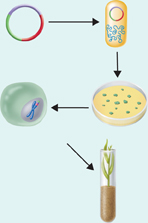15 Assessment
15.1 Selective Breeding
Understand Key Concepts
Crossing dissimilar individuals to bring together their best characteristics is called
domestication.
inbreeding.
hybridization.
polyploidy.
Crossing individuals with similar characteristics so that those characteristics will appear in their offspring is called
inbreeding.
hybridization.
recombination.
polyploidy.
Taking advantage of naturally occurring variations in organisms to pass wanted traits on to future generations is called
selective breeding.
inbreeding.
hybridization.
mutation.
How do breeders produce genetic variations that are not found in nature?
What is polyploidy? When is this condition useful?
Propose a Solution Suppose a plant breeder has a thornless rose bush with scentless pink flowers, a thorny rose bush with sweet-smelling yellow flowers, and a thorny rose bush with scentless purple flowers. How might this breeder develop a pure variety of thornless, sweet-smelling purple roses?
Compare and Contrast Hybridization and inbreeding are important methods used in selective breeding. How are the methods similar? How are they different?
Think Critically
15.2 Recombinant DNA
Understand Key Concepts
Organisms that contain genes from other organisms are called
transgenic.
mutagenic.
donors.
clones.
What process is shown below?
cloning
transformation
hybridization
polymerase chain reaction
When cell transformation is successful, the recombinant DNA
undergoes mutation.
is treated with antibiotics.
becomes part of the transformed cell's genome.
becomes a nucleus.
Bacteria often contain small circular molecules of DNA known as
clones.
chromosomes.
plasmids.
hybrids.
A member of a population of genetically identical cells produced from a single cell is a
clone.
plasmid.
mutant.
sequence.
Describe what happens during a polymerase chain reaction.
Explain what genetic markers are and describe how scientists use them.
How does a transgenic plant differ from a hybrid plant?
Table of Contents
- Formulas and Equations
- Applying Formulas and Equations
- Mean, Median, and Mode
- Estimation
- Using Measurements in Calculations
- Effects of Measurement Errors
- Accuracy
- Precision
- Comparing Accuracy and Precision
- Significant Figures
- Calculating With Significant Figures
- Scientific Notation
- Calculating With Scientific Notation
- Dimensional Analysis
- Applying Dimensional Analysis





